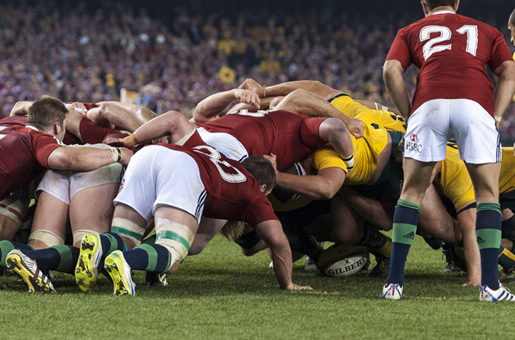Body Shape / Height
The best way for Alexander to attack is to stop the loosehead from getting his head under his chest in the first place and that is best achieved by getting lower than the loosehead so there is no room for them to get under his chest as shown here by Owen Franks. Franks restricts what Sekope Kepu can do because it’s not physically possible for Kepu to get any lower so he can engage under Franks.
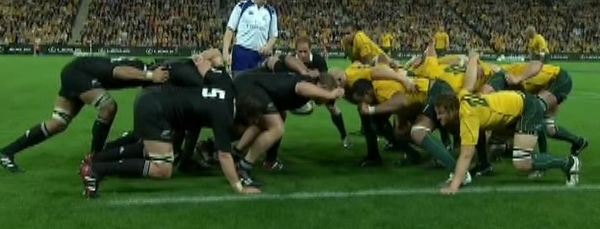
Because props need to keep their back flat, getting low isn’t about getting the shoulders down lower – it’s about getting the hips lower and keeping the shoulders at the same height as the hips. As you can see from both Franks and Kepu they get lower by bending their knees to lower their hips, not by starting with their shoulders below their hips.
This is where Alexander’s technique is poor and why a good loosehead can cause him big problems. He sets up with his legs nearly straight and his shoulders below his hips as you can see from the image below of that scrum where he got driven backwards. This allows Alex Corbisiero to start that much lower than him.
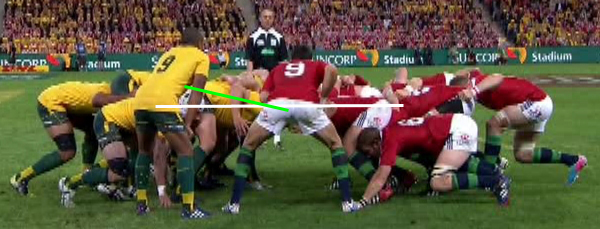
By starting with his hips so high, if the loosehead does get under him he’s in a dreadful position to try and resist being popped up. As you’ll see in the video below this is exactly what happened in this scrum where Corbisiero gets under him, lifts his chest up and then drives him backwards. With Alexander so high Corbisiero didn’t even have to drop his head down very far to get under him.
Contrast this with how Adam Jones on the Lions right side of the scrum counters Benn Robinson in the second test where as you can see before the engagement he’s in a lower position than Robinson. Jones is a big man who you wouldn’t say is the epitome of fitness and flexibility – if he can get down this low, Alexander should also be able to.
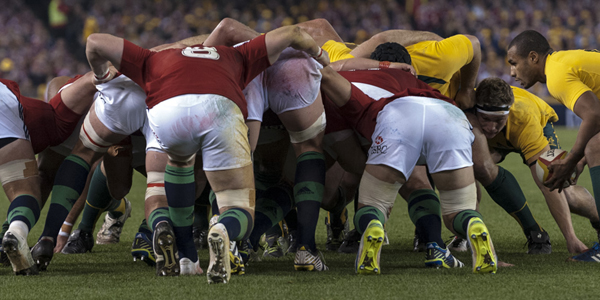
If the tighthead can’t stop the loosehead getting under them, the next best thing to do is to keep them down in that horrible position I showed you earlier – if they can’t get up so their back is parallel to the ground they’ll either lose their bind and collapse or if they manage to maintain their bind they will not be able to transfer the force coming from behind them and will go backwards and hinge as shown earlier. It’s not an easy thing for a loosehead to do and the tighthead can use that to their advantage.
Robinson has been struggling to get under Jones in the first two tests and even when he does Jones has been able to counter Robinson on most occasions by keeping him down. Whilst the scrum laws say the props must push forward and flat, that’s not the reality of what happens in scrums – the loosehead pushes forward and up and to counter this the tighthead pushes forward and down. If they are both good props they counter each other and they both end up pushing flat. As you can see from the image below even after the engagement Jones uses his weight and technique to hold Robinson down. I’ll talk more about Vunipola’s position in part two.
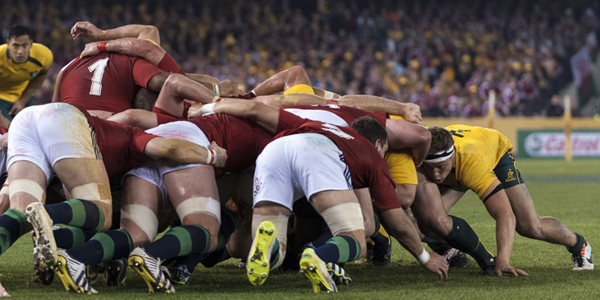
Once the tighthead goes backwards they will either start to lift up or fold in whilst the loosehead continues driving with their head on the tighthead’s chest and naturally follows where the tighthead is going – up or in, or both. Whilst this may look like the loosehead is at fault and sometimes that’s exactly what has happened, most of the time a weak tighthead or one using poor technique gets dominated and actually causes the loosehead to roll in and up.
The Lions scrum was significantly de-powered for this series when Cian Healy and Gethin Jenkins, their two best looseheads, were injured and had to leave the tour. It was Alexander’s poor body shape / height that helped Healy dominate him in the RWC 2011 clash between the Wallabies and Ireland.
Vunipola is not the best scrummager and Alexander has fared reasonably against him. I expect Corbisiero will come back into the Lions starting side this week and he is a better scrummager than Vunipola so there will be more of a challenge for Alexander.
Many of the images I’ve used in this article come from Shane Sullivan and Tim Anger who have been on field for the tests and have provided these images to us. Fortunately for us Sully also managed to shoot a sequence of sixteen shots from that scrum in Brisbane where the Wallabies went backwards so badly which help reveal some fantastic detail of how scrums really work. Those images and the dissection of that scrum are included in the video below.
In part two I’ll discuss how the vertical angles in a scrum work. This is particularly relevant for what happened in the second test and may happen in the third test. Whilst it may have appeared that Vunipola was boring in from the side on Alexander, that impression was amplified due to the tactics the Wallabies were using when the Lions were feeding the scrum to try and take advantage of a real issue Vunipola has with his scrummaging.
The Wallabies’ tactic worked a few times but once Vunipola worked out (or was told) how to counter it he turned the tables and used the angles to really disrupt Alexander, which I expect Corbisiero will also try to do.
We are a fan run website, we appreciate your support.
💬 Have you got a news article suggestion? Submit a story and have your say
👀 Follow us on Facebook, Instagram and X.com
🎵 Listen to our Podcasts on Spotify and iTunes
🎥 Watch our Podcasts on YouTube

